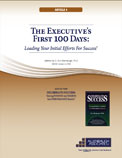The Critical First 100 Days
If you are in a new position or about to make a key career change,
carefully read the following…
The actions of a newly appointed top executive — whether by intention or default — communicate a mindset of expectations within the organization that may well follow that new leader throughout the duration of his or her tenure. This limited window of opportunity can have a profound impact on positioning key stakeholders to co-create an even brighter future for the organization — or this same time period can cause people to go into resistance and rejection. How the new leader navigates through The First 100 Days will likely make a permanent imprint in the minds of stakeholders — an imprint that will either contribute to or detract from the executive’s long-term effectiveness.
Stakeholders carefully observe and listen to the new leader as they tune into WIIFM — “What’s in it for me?” In some cases, people seek stability and continuity from the new leader. In others, associates are looking for a fresh perspective and bold actions to confront unresolved issues and prepare the organization for a brighter future. People simultaneously experience a sense of excitement and anxiety about how the leadership change will impact them, their direction, their way of doing business, and their priorities. Some fear change while others fear there won’t be enough change. The new leader needs to wisely and boldly sort through these challenges.
nor the most intelligent,
but the ones most responsive to change.”
— Charles Darwin
Wise leaders listen, learn, absorb, and synthesize a great deal of tangible and intangible information during this critical period about the culture, the history, the politics, the priorities, and the values. They also learn about what works and what doesn’t, who works and who doesn’t, what’s important and what’s not. Wise leaders pause before acting – especially in a new environment. This thoughtful, systematic process builds confidence and trust in the new leader. Being too cautious during the First 100 Days, however, may communicate a lack of courage and turn the hopeful into skeptics.
Courageous leaders also look for opportunities to clarify direction, inspire people, build bridges, and create a sense of movement. Even during the First 100 Days, bold leaders take conscious, deliberate action in addressing symbolic issues that reinforce principles, clarify direction, and mobilize the positive spirit of people. A new executive is essentially “bullet-proof.” If the new executive makes a mistake, most people are willing to give him or her the benefit of the doubt, forgive, and move on. When the executive promptly resolves a high-profile issue requiring attention, stakeholders notice and are more likely to come on board — or at least be more open to the new leader’s influence. If nothing happens during the First 100 Days, however, people may conclude that the new executive is just “another bureaucrat” who will merely shuffle papers and avoid dealing with the issues.
but an opportunity to be seized.
The choice is ours.”
— Sam Weiss
Effective leaders both assimilate and act during this initial window of opportunity. Knowing what to address and how to go about doing that during the First 100 Days distinguishes the good from the great leaders. In the depth of The Depression, for example, newly elected President F.D. Roosevelt immediately reopened the banks and pumped money back into the system. That bold move lifted spirits, gave people hope, and began the important process of restoring confidence in the economy. Lee Iacocca, during his First 100 Days as CEO of Chrysler, initiated several bold, swift moves that both challenged and mobilized people to act in ways they once thought inconceivable. On what priorities might you focus to positively engage stakeholders while building their hope for future possibilities?
Eric Allenbaugh has coached scores of executives in new positions to assume effective leadership roles and take positive action during this initial window of opportunity. In working with Dr. Allenbaugh, you can experience the confidence of knowing what and how to tackle the Critical First 100 Days — it’s what distinguishes the good from the great leaders. This executive coaching process will likely involve:
- Identifying how to smoothly engage in the unique culture of your new organization
- Building rapport and confidence with key stakeholders
- Planning and mobilizing for early, effective results
- Building a spirit of partnership, trust, and open communication
- Enrolling board members, executive staff, employees, corporate office, community groups, and key customers
- Identifying symbolic issues that can be resolved
- Confidently taking “home run” action on carefully selected issues
- Inspiring “we are on the move” confidence
- Balancing the high leadership demands of a new position with your personal life
- Building immediate and long-term strategies for organizational, team, and individual performance
Take advantage of what could be your best human capital investment of your career by calling Dr. Allenbaugh today at 503-635-3963.
It’s something you do with them.”
— Ken Blanchard






